
The deadly weekend in Chicago is the most recent indication of the soaring violence in the city. There have been 614 murders in the city so far this year — more than in New York and Los Angeles combined and the highest number in over a decade.
Nationwide, while the number of homicides declined for several years after 2008, it has risen in recent years. There were 15,696 murders in 2015, up by 7.1% from 2011 and 10.8% from 2014. The violence is concentrated in certain U.S. cities. Based on the FBI’s most recent Uniform Crime Report, 24/7 Wall St. reviewed the 25 American cities with the highest murder rates. Although Chicago has been making the news, it is St. Louis that leads the nation with nearly 60 murders reported for every 100,000 city residents in 2015.
[in-text-ad]
The explanation for the nationwide uptick in murders remains unclear. FBI Director James Comey has attributed the spike to viral internet videos showing police brutality, which he suggested may lead to less aggressive policing. Comey’s “viral video effect” explanation has been widely criticized for lacking proof and for suggesting police officers might be afraid to do their jobs.
Click here to see America’s 25 murder capitals.
The reasons for the surge in homicides are clearer, however, in some cities. For example, disruptions in illegal drug markets have been blamed for increased deadly violence in Baltimore, Maryland; Dayton, Ohio; and Oakland, California. Similarly, gang violence has been cited as a major driver of the increase in homicides in Chicago, Illinois; Salinas, California; and West Palm Beach, Florida.
Cities with high murder rates often share several economic characteristics. While the connection between poverty and violent crime is by no means a direct relationship, each of the 25 U.S. cities with the highest murder rates have a higher poverty rate than the nation as a whole. In Dayton, Ohio; Detroit, Michigan; and Hartford, Connecticut more than one in three city residents live at or below the poverty line, well more than double the 15.6% national poverty rate.
People are are also much more likely to be killed by someone they know than anyone else. The FBI reports that 42% of murder victims in the United States were verifiably killed by acquaintances or family members, and only 10.2% were killed by strangers. In the remaining 47.8% of last year’s homicide cases, the relationship between victim and perpetrator was not known.
Only 61.5% of murder cases nationwide in 2015 were solved. In the cities with the highest murder rates, the share of murder cases that were solved — also known as the murder clearance rate — varied dramatically. In Atlanta, which recently established a special police unit to address gun violence, has an 80% murder clearance rate. By contrast, Baltimore police solved only 30.5% of homicides last year. Baltimore is notorious for its “stop snitching” culture, which discourages any cooperation with police investigations.
Firearms are by far the most commonly used murder weapon. Nearly 72% of all 2015 murders with a known weapon were committed with a firearm. In some of the cities with the highest murder rates, the share is far higher. In both Baltimore and Chicago, firearms were involved in more than 85% of homicides. Though Chicago has relatively strict gun laws, the city is flooded with illegal guns from out of state, and officials have failed to implement policies to reduce gun violence — policies that have been successful in cities such as New York.
To identify the cities with the highest murder rates, 24/7 Wall St. reviewed data from the FBI’s Uniform Crime Reporting Program in 2015’s “Crime in the United States Report.” Homicide figures, also referred to as murder or nonnegligent manslaughter, generally refer to deaths that occur as the result of a fight, assault, or commission of a crime. Cities were ranked by their murder rate: the total number of murders in 2015 adjusted for population. Murder rates are expressed as the number of murders for every 100,000 citizens. Poverty rates are for 2015 and came from the Census Bureau’s American Community Survey. Unemployment rates are annualized for 2015 and came from the Bureau of Labor Statistics.

25. North Charleston, South Carolina
> Murder rate: 17.4 per 100,000
> No. of murders: 19
> Violent crime rate: 735.4 per 100,000
> Population: 109,051
There were 19 murders in North Charleston in 2015, fewer than the 23 murders that took place in 2014. Although lower than 2014, the city’s 2015 murder rate was up 280% from half a decade ago — and appears to be climbing. There were 15 murders in North Charleston in the first half of 2016 alone, setting the city’s total murder count on pace for a 58% year over year increase.
[in-text-ad]
North Charleston is adjacent to Charleston, which last year was the scene to one of the worst mass shootings in modern American history. The nine churchgoers gunned down by Dylann Roof during Bible study on June 17, 2015 at the Emanuel AME Church were not factored into North Charleston’s murder rate.
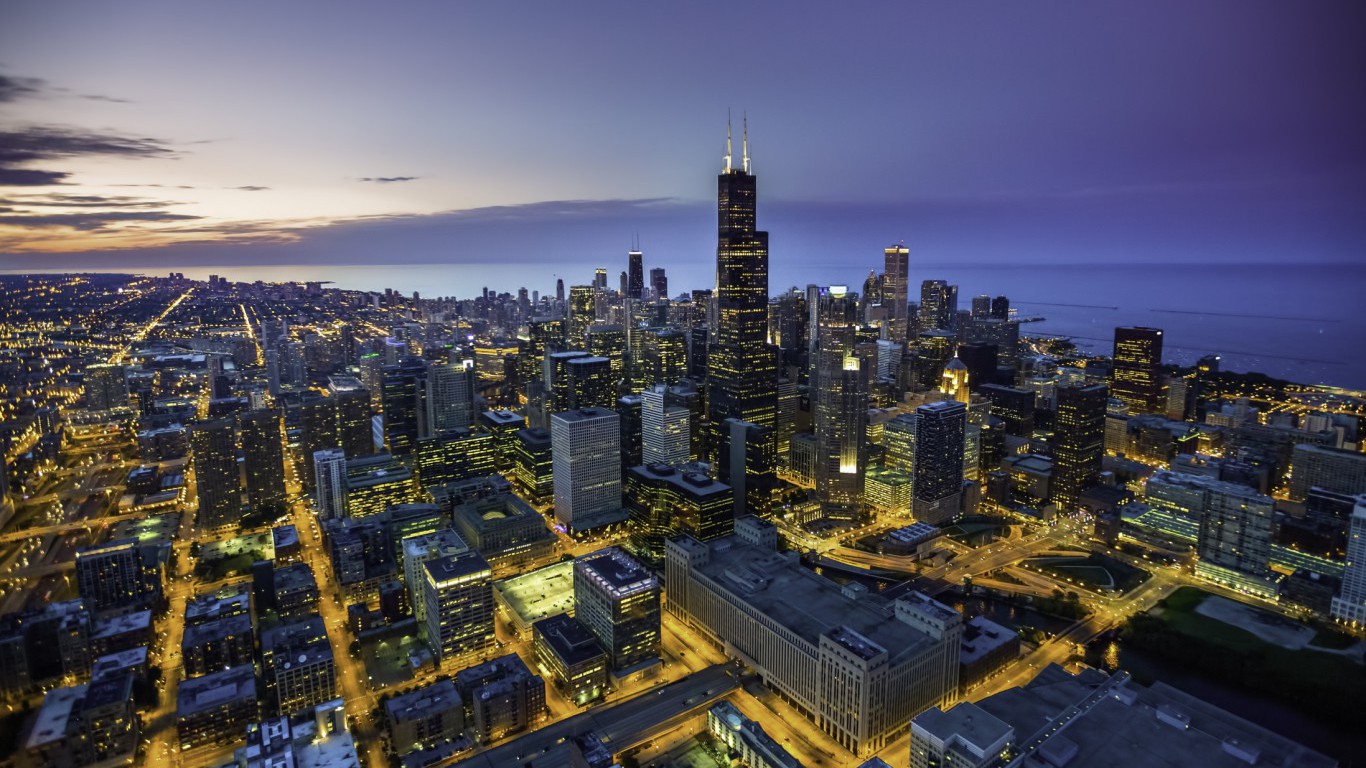
24. Chicago, Illinois
> Murder rate: 17.5 per 100,000
> No. of murders: 478
> Violent crime rate: 903.8 per 100,000
> Population: 2,728,695
Chicago has recently garnered nationwide attention from the media and politicians for a catastrophic level of gun violence on its streets. There were more homicides in Chicago last year than in any other American city. The number of murders in 2015 reflect a 16.3% increase from the previous year and a 10.9% increase from 2011. Conditions are not getting better in the Midwestern city. After an especially deadly October, with 18 homicides over Halloween weekend alone, the number of 2016 murders in Chicago now exceeds 600, well above the 478 total in 2015. Gang violence is the primary cause of murder in Chicago.
With more than 2.7 million residents, the Windy City is one of the largest in the country. Though murder and gun violence in the city has dominated headlines nationwide, after adjusting for population, Chicago’s 2015 murder rate trails that of nearly two dozen other U.S. cities.

23. Philadelphia, Pennsylvania
> Murder rate: 17.9 per 100,000
> No. of murders: 280
> Violent crime rate: 1,029.0 per 100,000
> Population: 1,567,810
With more than 1.5 million residents, Philadelphia is the fifth largest U.S. city. Crime, including murder, tends to increase with population size, and Philadelphia had 280 homicides last year, more than in all but half a dozen other U.S. cities.
By the beginning of 2016, nearly half of the city’s murders from the previous year remained unsolved. City officials have blamed the poor homicide arrest rate on the city’s “stop snitching” culture, which originated in Baltimore and is designed to discourage cooperation with police investigations. In order to combat the prevailing culture, the Philadelphia Police Department offers $20,000 to anyone who provides information that leads to the arrest and conviction of a killer.

22. Dayton, Ohio
> Murder rate: 18.5 per 100,000
> No. of murders: 26
> Violent crime rate: 941.8 per 100,000
> Population: 140,683
Violent crime tends to be more common in economically depressed areas. In Dayton, Ohio, a city with an especially high annual murder rate, more than a third of the population lives below the poverty line. A majority of Dayton residents, even those who are not living in poverty, are likely struggling financially, as the typical Dayton household earns only $28,174 a year, about $25,000 less than the national median.
Limited economic opportunities in Dayton, and across Ohio, have likely led to violence linked to drug trafficking. Multiple murders in Dayton this year appear to be drug related. In nearby Pike County, police blame an execution style killing that left eight family members dead on a Mexican cartel.

21. Pittsburgh, Pennsylvania
> Murder rate: 18.6 per 100,000
> No. of murders: 57
> Violent crime rate: 706.2 per 100,000
> Population: 306,870
While Pittsburgh’s annual murder rate fell 17.4% from 2014, the number of non-fatal shootings increased over the same time period. Further, the city’s police chief acknowledged that the Pittsburgh police force was understaffed in 2015, an issue Mayor Bill Peduto promised to address.
The sizeable decline in the city’s murder rate is a break from the 10.8% nationwide spike in homicides. Still, compared to five years ago, Pittsburgh’s annual murder rate remains up by nearly 30%. It was one of two Pennsylvania cities with a near nation-leading homicide rate last year.
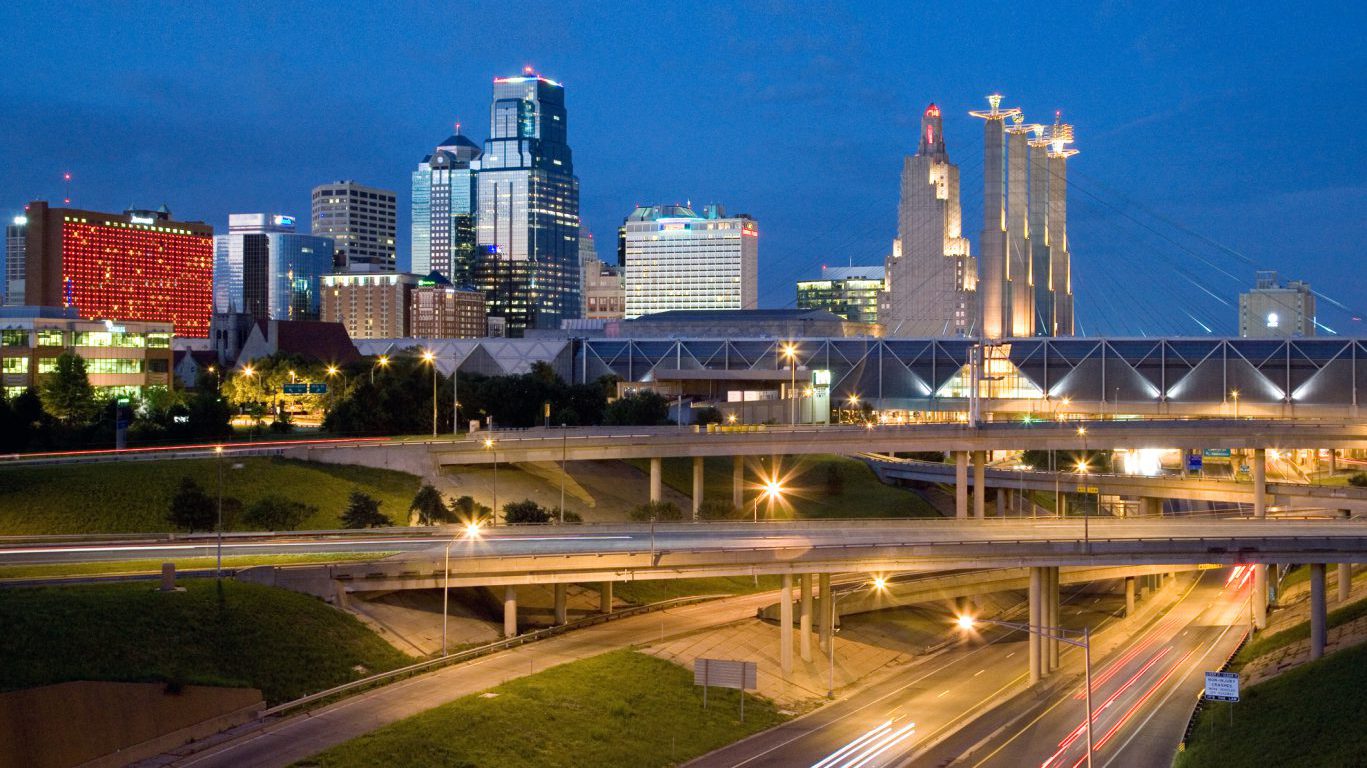
20. Kansas City, Kansas
> Murder rate: 18.6 per 100,000
> No. of murders: 28
> Violent crime rate: 773.3 per 100,000
> Population: 150,370
Though dozens of U.S. cities had far more murders than the 28 homicides that took place in Kansas City last year, when accounting for the city’s relatively small population, Kansas City’s 2015 murder rate is strikingly high. There were 19 murders in Kansas City for every 100,000 residents last year, a higher rate than in the majority of U.S. cities.
[in-text-ad]

19. Richmond, Virginia
> Murder rate: 19.5 per 100,000
> No. of murders: 43
> Violent crime rate: 515.8 per 100,000
> Population: 220,802
Economic conditions can deeply affect the incidence of violent crime in an area. Lower-income areas tend to have higher crime and murder rates than higher-income areas. In Richmond, about one in four residents live below the poverty line, a far larger share than the 15.6% national poverty rate.
There were 19.5 murders last year for every 100,000 Richmond residents, one of the highest murder rates in the country. More than half of the 43 murders that took place in the city in 2015 remain unsolved.
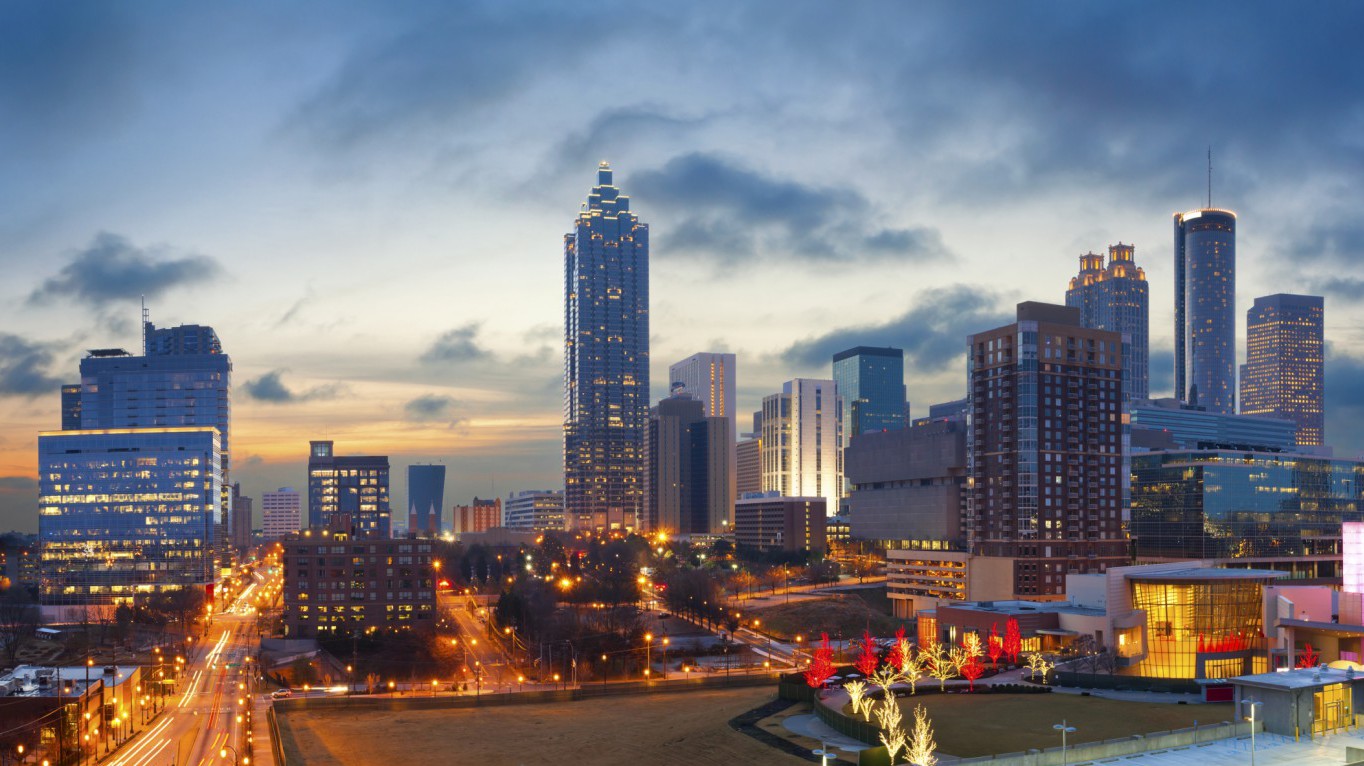
18. Atlanta, Georgia
> Murder rate: 20.2 per 100,000
> No. of murders: 94
> Violent crime rate: 1,119.6 per 100,000
> Population: 464,710
The number of homicide victims in Atlanta last year is up 1.1% from 2014 and 6.8% from half a decade ago. Gun deaths are especially common. Across Georgia, guns are involved in 82% of all murder cases compared to 71.5% of cases nationwide. In Atlanta, the number of gun-related deaths is up slightly in 2016. In an effort to address gun violence, Atlanta Mayor Kasim Reed established the Gun Violence Reduction Task Force, which includes a 45-person patrol team specifically assigned to areas with high gun violence.
While the city consistently ranks among the worst in the country for total incidents of murder and nonnegligent manslaughter, killers are not likely to escape justice. The Atlanta Homicide Unit solves 80% of murders, while nationwide fewer than 62% of murder cases are solved.

17. Oakland, California
> Murder rate: 20.3 per 100,000
> No. of murders: 85
> Violent crime rate: 1,442.5 per 100,000
> Population: 419,481
With roughly 20 murders for every 100,000 residents, Oakland had one of the highest murder rates in the country last year. Though the total incidence of homicides in the city increased by 6.3% last year, the number of murders in 2015 remains 18.3% lower than in 2011. Oakland police attribute the recent spike to increased gang, drug, and robbery related violence.
Robberies are a major problem in the city. Oakland’s 2015 robbery rate of 784.3 reported incidents per 100,000 residents was the highest in the country.

16. San Bernardino, California
> Murder rate: 20.3 per 100,000
> No. of murders: 44
> Violent crime rate: 1,245.9 per 100,000
> Population: 216,477
San Bernardino was the site of the deadliest mass shooting in the United States in three years. The 14 people gunned down on December 2, 2015 at the Inland Regional Center contributed significantly to the city’s overall 2015 homicide rate.
While there have been no mass shootings of in the city so far this year, the murder rate is on the rise. As of mid-September 2016, 51 homicides had been reported in San Bernardino, compared to the 44 for all of 2015.

15. Memphis, Tennessee
> Murder rate: 20.5 per 100,000
> No. of murders: 135
> Violent crime rate: 1,740.1 per 100,000
> Population: 657,936
Last year, 135 people were murdered in Memphis, Tennessee. The total incidence of homicide in the city reflects a 3.6% improvement from the previous year but a 15.4% increase since 2011.
[in-text-ad]
According to an official from the Memphis Police Department, arguments are the primary motive for homicide in the city, followed by robbery. Robberies tend to be more common in economically disadvantaged areas, and more than one in four Memphis residents live below the poverty line. The city’s robbery rate was the ninth highest in the country last year.

14. West Palm Beach, Florida
> Murder rate: 21.0 per 100,000
> No. of murders: 22
> Violent crime rate: 880.7 per 100,000
> Population: 104,919
Murder in West Palm Beach has climbed considerably in recent years. There were 22 homicides in the city in 2015, a 46.7% increase from the previous year and a 57.1% jump from half a decade ago.
Police blame the recent surge in violence on “cliques,” which are similar to gangs, only less organized and without a clear hierarchy. While the motives behind many killings in the city remain unclear, they are likely the result of personal disputes. In response to the escalating violence, police have quadrupled patrol hours in certain parts of the city.
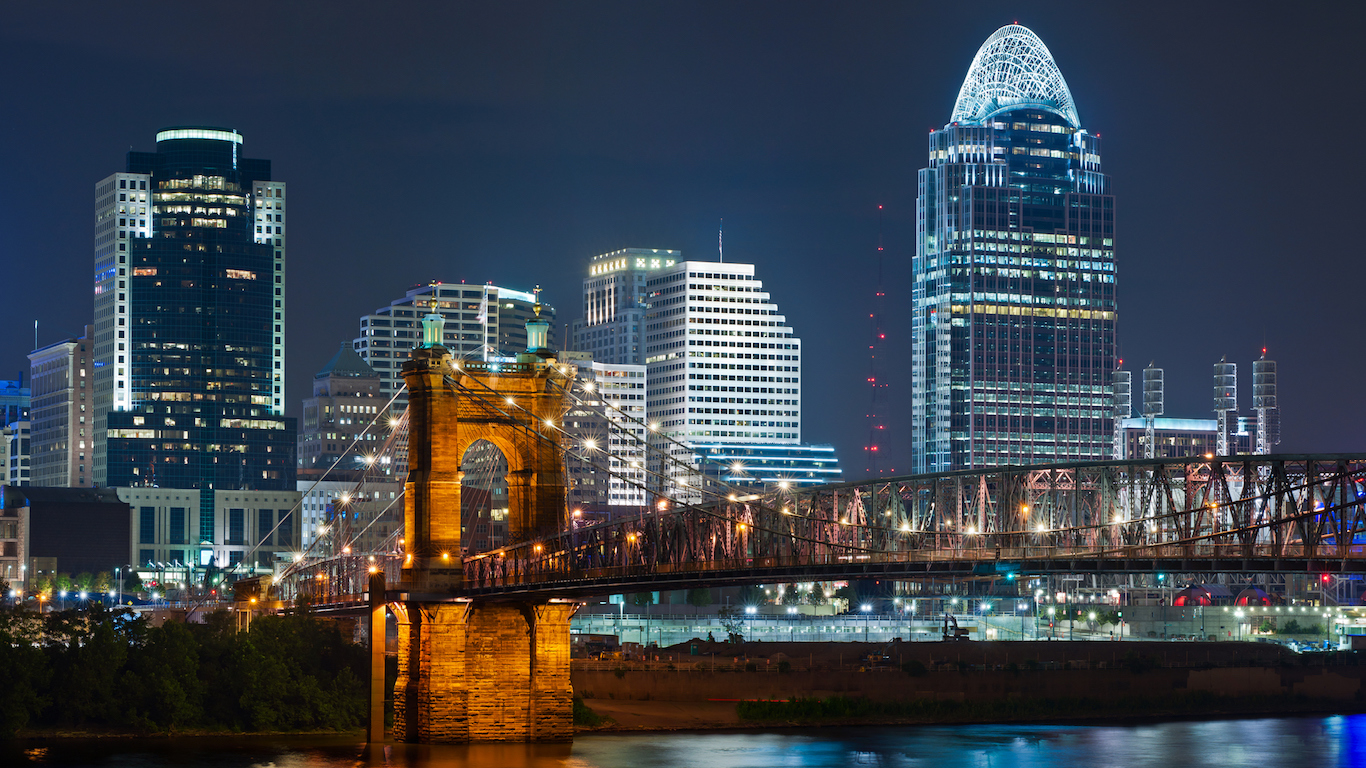
13. Cincinnati, Ohio
> Murder rate: 22.1 per 100,000
> No. of murders: 66
> Violent crime rate: 925.0 per 100,000
> Population: 298,478
Most of the 66 homicides in Cincinnati last year involved guns. As the number of murders in the city are up 8.2% from five years ago and up 10.0% from 2014, Cincinnati’s murder rate ranks among the worst in the country. Concurrently, the number of non-fatal shooting victims is up 31.2% from 2014.
In an interview with the Cincinnati Enquirer, Mayor John Cranley announced that reducing the number of shootings in the city is the top priority of his administration. In September 2015, the steadily increasing violence led to a sea change in the city’s police department’s leadership. With a newly appointed police chief, the mayor’s office hopes to make progress through improved relations between police and the community.
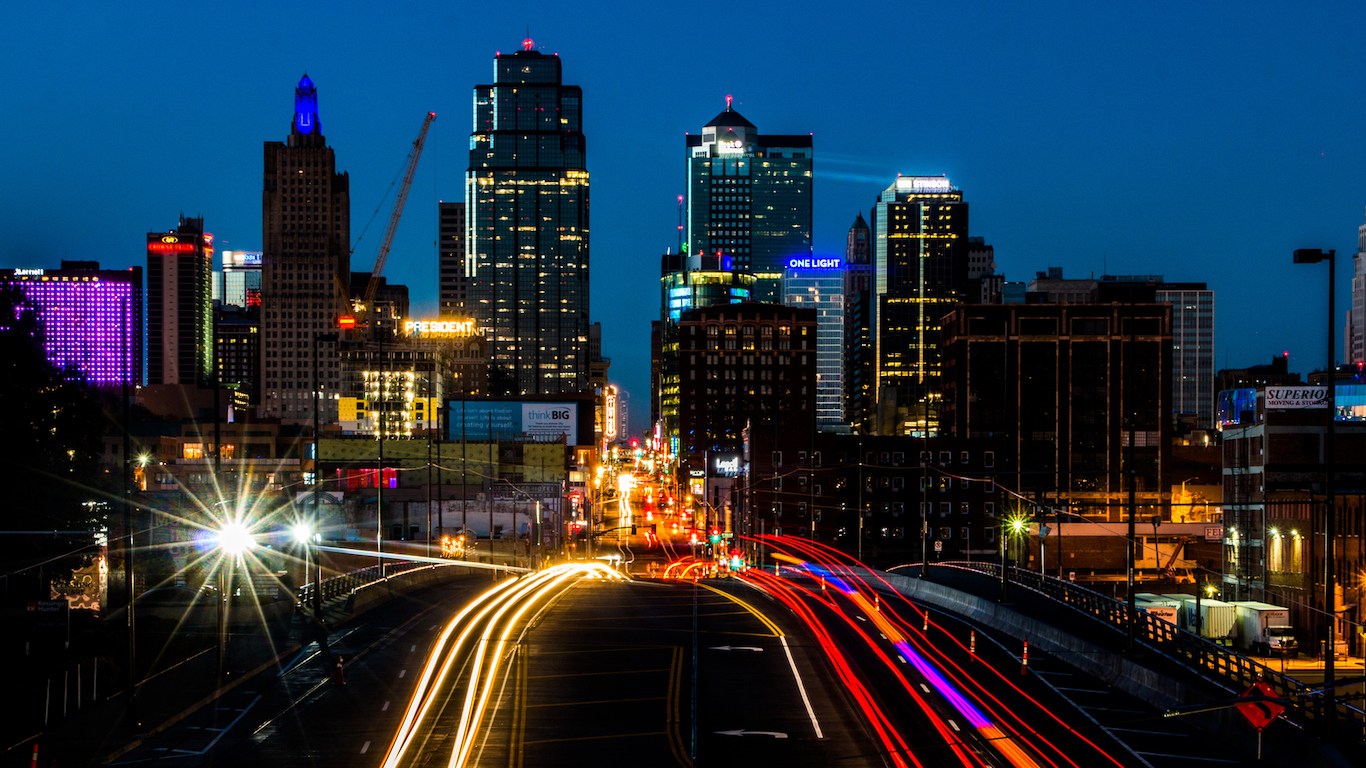
12. Kansas City, Missouri
> Murder rate: 23.0 per 100,000
> No. of murders: 109
> Violent crime rate: 1,417.3 per 100,000
> Population: 473,373
Larger than its neighboring city of the same name across the Kansas state line, Kansas City, Missouri also has a higher annual murder rate. With 109 murders in the city in 2015, the murder rate of 23 incidents for every 100,000 residents was higher than in all but 11 other American cities.
According to the Kansas City Police Department, 35 killings from last year remain unsolved.

11. Washington, District of Columbia
> Murder rate: 24.1 per 100,000
> No. of murders: 162
> Violent crime rate: 1,202.6 per 100,000
> Population: 672,228
Washington D.C.’s murder rate is on the rise. The 162 murders in the city last year represented a 50.0% increase from 2011 and a 54.3% spike from 2014. Of the all the murders that took place in the District of Columbia last year, only 29 have been solved.
In an interview with the Washington Times, the city’s assistant police chief explained that a greater number of shell casings are being discovered at crime scenes. More shell casings suggest shooters are using modified weapons and extended magazines, which increase the likelihood of a fatality.
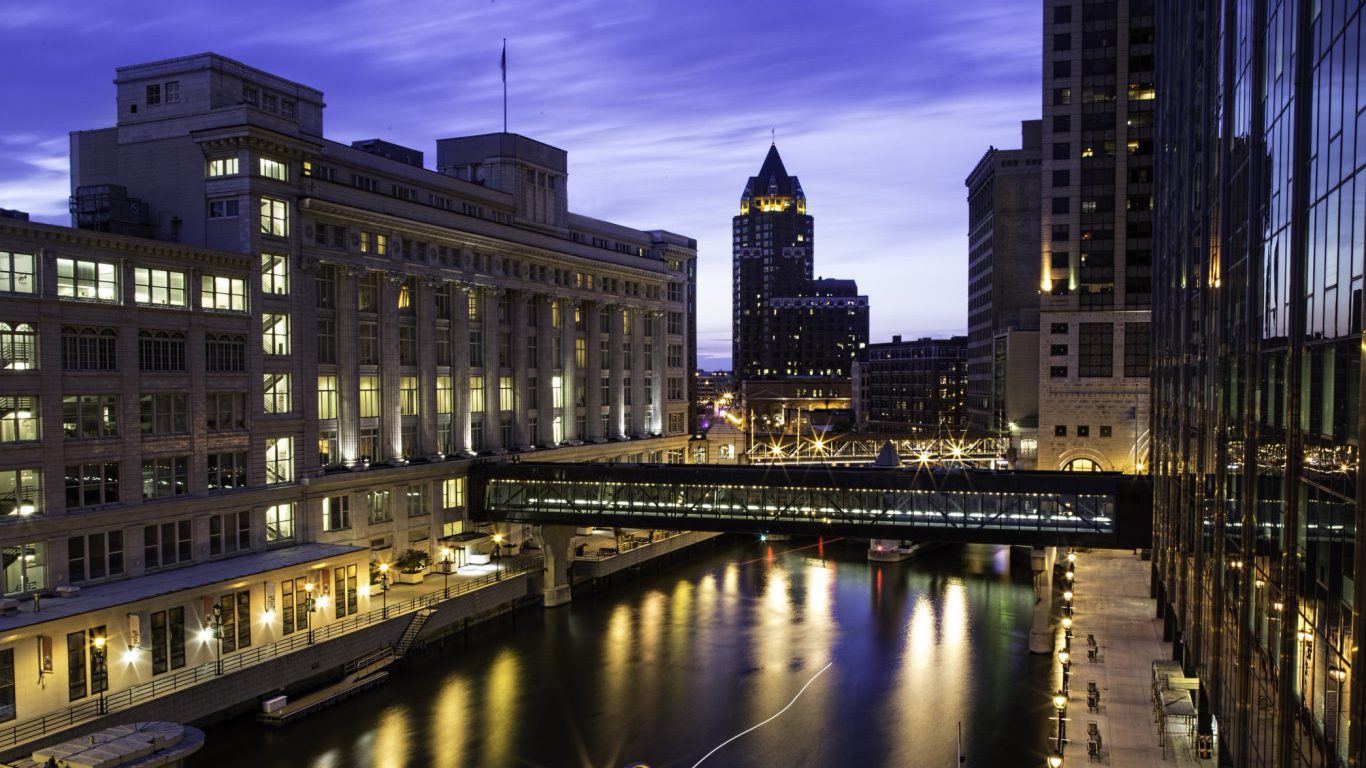
10. Milwaukee, Wisconsin
> Murder rate: 24.2 per 100,000
> No. of murders: 145
> Violent crime rate: 1,596.1 per 100,000
> Population: 600,400
Milwaukee’s 2015 murder rate was the 10th highest in the nation and the third highest in the Midwest, trailing only Detroit and St. Louis. The incidence of homicide in the city spiked 70.6% from half a decade ago, one of the sharper increases of any U.S. city.
[in-text-ad]
Arguments and fights were the most common motives behind murders in Milwaukee last year, followed closely by robberies. Robberies are more common in financially distressed areas, and in Milwaukee, 29.4% of the population live in poverty, nearly double the national rate. Last year, there were 624 robberies in Milwaukee for every 100,000 residents, the third highest rate of any U.S. city.

9. Salinas, California
> Murder rate: 25.3 per 100,000
> No. of murders: 40
> Violent crime rate: 694.1 per 100,000
> Population: 158,185
The murder rate in Salinas hit a three-decade high last year. The 40 murders in the city in 2015 represented a 166.7% increase from the previous year, one of the largest homicide spikes in the country. The increase came even as the number of reported nonviolent property crimes dropped by 20.7%.
While, as always, gang violence was behind many of the city’s murders, local officials blamed the sharp spike in murders on an increase in drug-related violence and domestic disputes.

8. Hartford, Connecticut
> Murder rate: 25.7 per 100,000
> No. of murders: 32
> Violent crime rate: 1,140.9 per 100,000
> Population: 124,553
Although the relationship is complicated, it appears that low income, economically depressed areas are more prone to crime. Hartford’s unemployment rate is a near nation-leading 10.4%, and more than one in three Hartford residents live in poverty. At the same time, the city has one of the highest violent crime rates in the country. With 32 murders and fewer than 125,000 residents, Hartford had a higher murder rate than all but seven other U.S. cities last year.
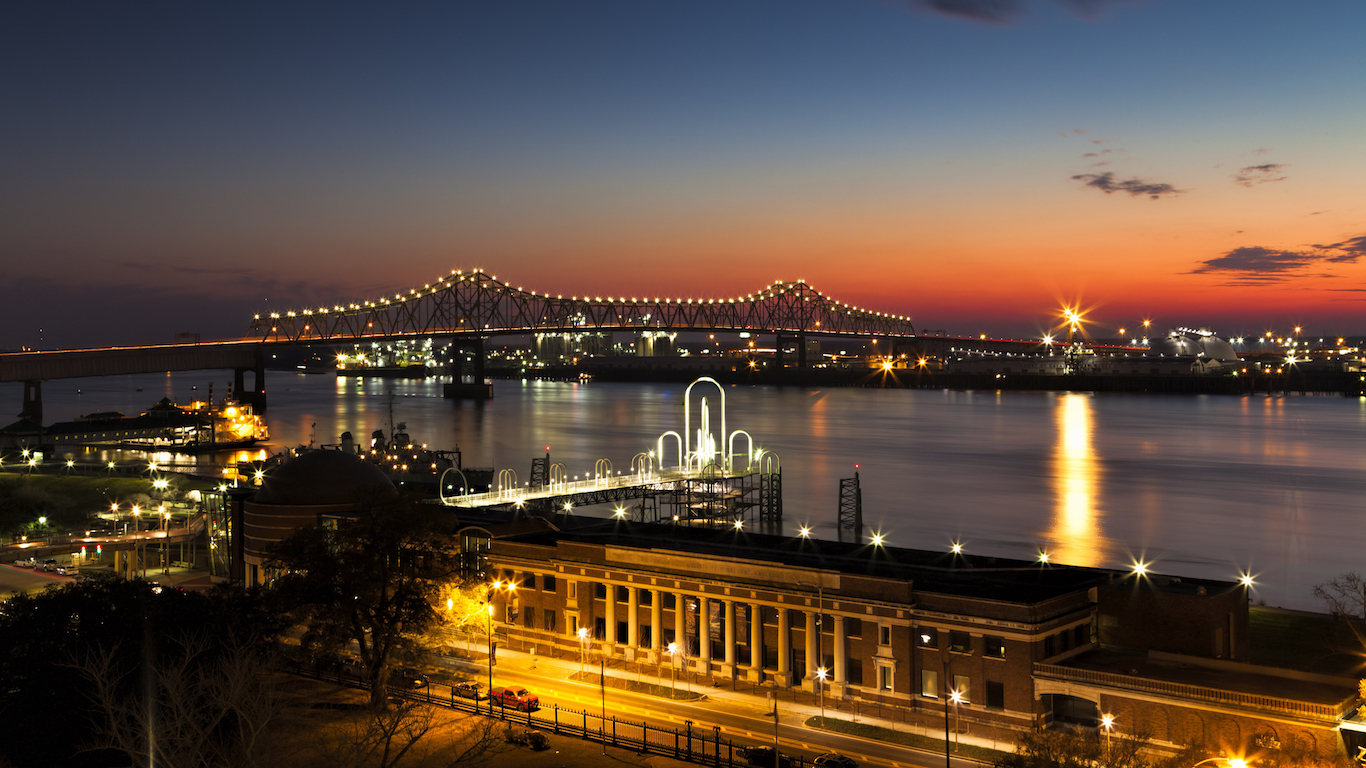
7. Baton Rouge, Louisiana
> Murder rate: 26.2 per 100,000
> No. of murders: 60
> Violent crime rate: 874.8 per 100,000
> Population: 228,727
There were 26 murders in Baton Rouge last year for every 100,000 residents, more than in all but half a dozen other cities. The 60 homicides in the city last year represents a 13.2% increase from the year before. City officials blame the spike on increased violence associated with drug trafficking. It is perhaps no coincidence that the city reported a record number of fatal heroin overdoses in 2015.
As in many other U.S. cities, the majority of homicides in Baton Rouge last year involved firearms. Gun violence continues to be a scourge on the Louisiana capital. On July 17, 2016, a former Marine shot and killed three Baton Rouge police officers with an AR-15 assault rifle.

6. Jackson, Mississippi
> Murder rate: 31.1 per 100,000
> No. of murders: 53
> Violent crime rate: 921.4 per 100,000
> Population: 170,508
Overall, the incidence of crime went down in Jackson, Mississippi in 2015. The city reported a 17.0% drop in property crime and a 1.4% decrease in violent crime. Among all violent crimes, the number of murders in the city declined most dramatically in 2015 — by 13.1% from 2014.
This decline in deadly violence, however, appears to have been short lived. The city logged its 50th murder case in mid-September this year, meaning 2016 will be far deadlier than 2015.
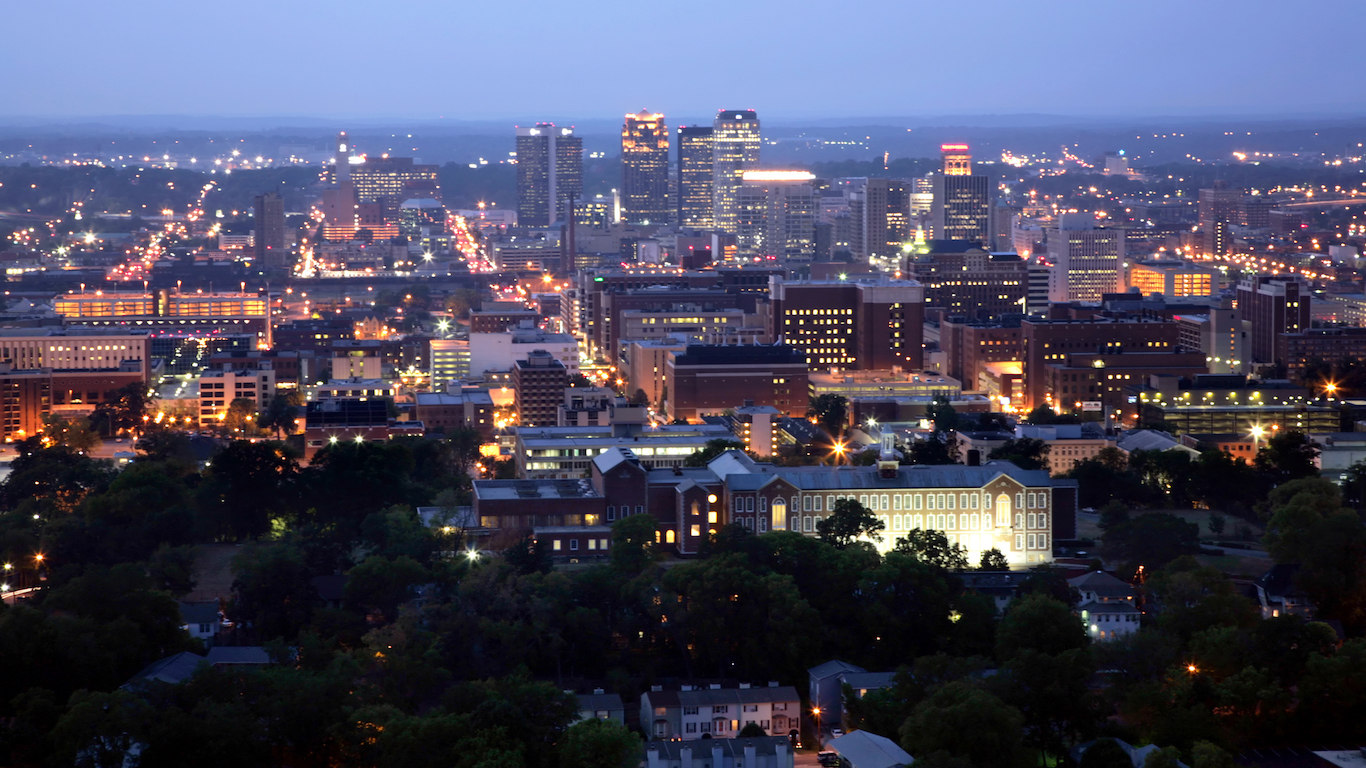
5. Birmingham, Alabama
> Murder rate: 37.2 per 100,000
> No. of murders: 79
> Violent crime rate: 1,746.2 per 100,000
> Population: 212,291
Birmingham is one of several cities in the deep south with far more murders per capita than is typical nationwide. The incidence of murder in 2015 was up 51.9% from 2014 and 46.3% from five years ago. According to statements made by Birmingham police, violence related to drug trafficking is the primary cause of the city’s high murder rate.
[in-text-ad]
Higher rates of violent crime often occur in economically depressed areas. The typical Birmingham household earns only $31,217 annually, and 31% of area residents live below the poverty line, each among the worst of all U.S. metropolitan areas.

4. New Orleans, Louisiana
> Murder rate: 41.7 per 100,000
> No. of murders: 164
> Violent crime rate: 949.6 per 100,000
> Population: 393,447
Poverty can often be an accurate measure in predicting violence, and in New Orleans, 27.7% of the population lives below the poverty line — one of the largest shares of any city in the country.
Gun violence in particular is a major problem across the state. Louisiana has the second highest gun fatality rate in the country. In New Orleans specifically, while the number of homicides in 2015 is up 9.3% from 2014, the longer term trend reveals a considerable decrease in murder in the city. Over five years, the number of murders in the city has declined by 18.0%, and are now nowhere near the quarter century high of 424 murders in 1994.
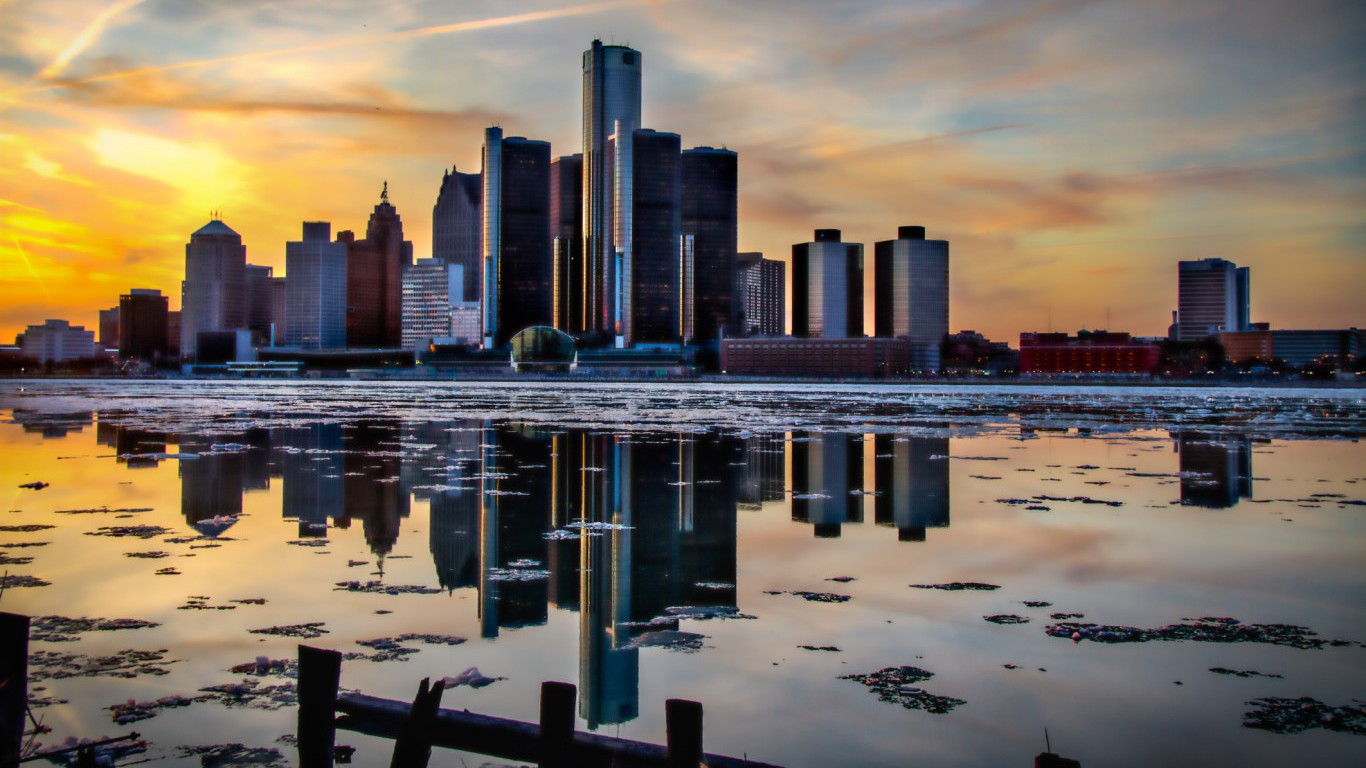
3. Detroit, Michigan
> Murder rate: 43.8 per 100,000
> No. of murders: 295
> Violent crime rate: 1,759.6 per 100,000
> Population: 673,225
The incidence of violent crime, a category which includes murder, rape, robbery, and aggravated assault, went up by 3.9% nationwide in 2015. In Detroit, however, the incidence of violent crime declined by 13.0% last year. Despite the improvement, homicide remains a major problem in Motor City. There were 295 murders in the city, or 43.8 homicides for every 100,000 city residents in 2015, the third highest murder rate in the country.
Detroit’s high murder rate is likely in part the result of its dismal economy. Nearly 40% of city residents live in poverty, and 12.4% of the workforce was unemployed as of 2015, each the highest share of any major U.S. city.

2. Baltimore, Maryland
> Murder rate: 55.4 per 100,000
> No. of murders: 344
> Violent crime rate: 1,535.9 per 100,000
> Population: 621,252
There were 344 homicides in Baltimore in 2015, more than the city has had since 1993, when there were 353 murders. However, Baltimore had significantly larger population in 1993, and after adjusting for population changes, 2015 was the deadliest in the city’s history. The number of murders in the city also increased by 63.0% from 2014, and the number of non-fatal shootings in 2015 was up 72% from 2014.
The spike in homicides in Baltimore has garnered national attention, but none have yet to draw a conclusive explanation. Theories range from violence connected to a flood of opioids looted from pharmacies during riots, spurred by the 2015 death of Freddie Gray in police custody, to a decline in public perception of police authority. Less than one-third of last year’s murders in Baltimore have been solved.

1. St. Louis, Missouri
> Murder rate: 59.3 per 100,000
> No. of murders: 188
> Violent crime rate: 1,817.1 per 100,000
> Population: 317,095
The 2015 murder rate in St. Louis of 59.3 incidents for every 100,000 city residents was the highest rate of any American city. Murder has become increasingly common in St. Louis in recent years. The 188 murder cases in 2015 represents an 18.2% increase from 2014 and a 66.4% increase from 2011. The majority of murder victims in St. Louis in 2014 and most of 2015 were young African-American males.
The motives behind many murders in the city range from personal disputes to disputes related to drug trafficking. The city made plans to increase the size of its police force in hopes of slowing the increase in the homicide rate.
Get Ready To Retire (Sponsored)
Start by taking a quick retirement quiz from SmartAsset that will match you with up to 3 financial advisors that serve your area and beyond in 5 minutes, or less.
Each advisor has been vetted by SmartAsset and is held to a fiduciary standard to act in your best interests.
Here’s how it works:
1. Answer SmartAsset advisor match quiz
2. Review your pre-screened matches at your leisure. Check out the advisors’ profiles.
3. Speak with advisors at no cost to you. Have an introductory call on the phone or introduction in person and choose whom to work with in the future
Thank you for reading! Have some feedback for us?
Contact the 24/7 Wall St. editorial team.
 24/7 Wall St.
24/7 Wall St.



